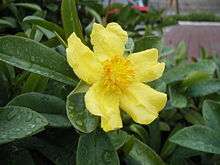Hibbertia scandens
| Snake vine | |
|---|---|
 | |
| Scientific classification | |
| Kingdom: | Plantae |
| (unranked): | Angiosperms |
| (unranked): | Eudicots |
| (unranked): | Core eudicots |
| Order: | unplaced |
| Family: | Dilleniaceae |
| Genus: | Hibbertia |
| Species: | H. scandens |
| Binomial name | |
| Hibbertia scandens (Willd.) Dryand. | |
Hibbertia scandens (also known as snake vine, climbing Guinea flower or golden Guinea vine) is a vine which is native to Australia.
Description
The yellow flowers have been reported as having an unpleasant odour[1] variously described as similar to mothballs[2] or animal urine[3] or sweet but with "a pronounced faecel element".[3] The leaves are elliptic or obovate and average 6 cm in length.
Taxonomy
The species was first formally described in 1799 by German botanist Carl Willdenow who gave it the name Dillenia scandens. The specific epithet scandens is derived from Latin, and means "to climb". In 1805, Swedish botanist Jonas Dryander transferred the species into the genus Hibbertia.
Distribution
Hibbertia scandens occurs in an area that extends from south-eastern New South Wales upwards to north-east Queensland.
In popular culture
Hibbertia scandens appeared on an Australian postage stamp in 1999.
Cultivation
This species is commonly cultivated, and adapts to a wide range of growing conditions. Although it readily grows in semi-shaded areas, it flowers best in full sun.
See also
References
| Wikimedia Commons has media related to Hibbertia scandens. |
| Wikispecies has information related to: Hibbertia scandens |
- "Hibbertia scandens' (Willd.) Dryand.". Australian Plant Name Index (APNI), IBIS database. Centre for Plant Biodiversity Research, Australian Government.
- PlantNET - New South Wales Flora Online Hibbertia scandens
- Australian Native Plants Society (Australia): Hibbertia scandens
- ↑ "Environmental Protection Agency - Queensland Government - Snake Vine (Hibbertia scandens)" (PDF). Retrieved 2010-11-19.
- ↑ Indigenous plants of Greater Taree (third edition) (PDF). Greater Taree City Council. 2010. Retrieved 31 January 2012.
- 1 2 Hawksewood, Trevor J. (31 August 1992). "Diphucephala benhardti sp. nov.(Coleoptera: Scarabaediae:Melonthinae) from heathlands of north-eastern New South Wales, Australia and its association with Hibbertia flowers (Dilleniaceae)" (PDF). Giornale Italiano Di Entomologia. 6: 109–117. Retrieved 15 February 2010.